|
||||||||||||||||||||||||||||||||||||||||||||||||||||||||||||||||||||||||||||||||
|

| Parent: | Patient Administration (PRPA_DM000000UV) |
This is the identified variant of A_Encounter universal. This CMET supports the use case of closely coupled systems where the receiver only needs the patient encounter's identifier.
Encounter -- An interaction between a patient and care provider(s) for the purpose of providing healthcare-related services. Healthcare services include health assessment.
- id - one or more unique identifiers for this encounter (mandatory)
- code - type of encounter (such as ambulatory, inpatient, emergency, home health)
- effectiveTime - the time interval starting with the administrative onset of the encounter (e.g. admission, registration, patient arrival) and ending with the patient's departure (e.g. discharge). For active encounters the end of the effectiveTime range is the anticipated end date-time.
| A_Encounter identified | COCT_MT010001UV01 |
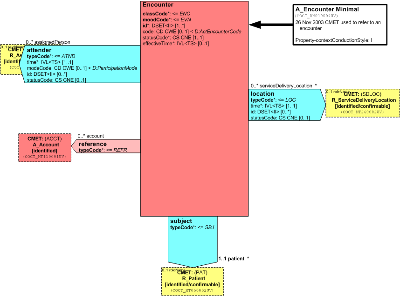
| Parent: | Patient Administration (PRPA_DM000000UV) |
This is the minimal variant of A_Encounter universal.
The encounter is described by type (e.g., ambulatory, inpatient), identifier(s), status, and effective time. The included participations are attending practitioner(s), assigned patient location(s), relevant account(s), and the patient. No act relationships are included.
| R_PatientIdentified/confirmable | COCT_MT050002UV07 |
| R_AssignedPersonIdentified/confirmable | COCT_MT090102UV02 |
| A_AccountIdentified | COCT_MT110001UV01 |
| R_ServiceDeliveryLocationIdentified/confirmable | COCT_MT240002UV02 |
| A_Encounter minimal | COCT_MT010004UV02 |
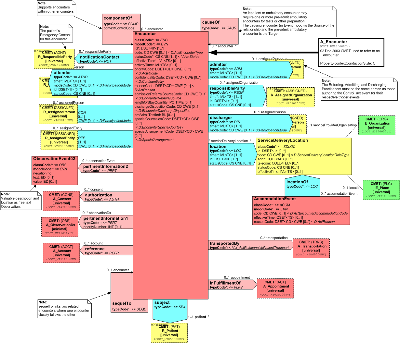
| Parent: | Patient Administration (PRPA_DM000000UV) |
This is the universal variant of A_Encounter . This CMET is used where the receiver is assumed to need all the data about a specific patient encounter in event mood.
Encounter -- An interaction between a patient and care provider(s) for the purpose of providing healthcare-related services. Healthcare services include health assessment.
- moodCode - A mandatory value specifying that this describes a patient encounter that actually happens (may be completed or ongoing).
- id - one or more unique identifiers for this encounter (mandatory)
- code - type of encounter (ambulatory, inpatient, emergency, home health, field or virtual; the last two types are not supported in this release of the standard)
- statusCode - distinguishes active from completed encounters
- effectiveTime - the time interval starting with the administrative onset of the encounter (e.g. admission, registration, patient arrival) and ending with the patient's departure (e.g. discharge). For active encounters the end of the effectiveTime range is the anticipated end date-time.
- activityTime - the total time interval for an encounter including preparation before the patient arrives and clean-up actions after the patient departs
- priorityCode - the encounter admission urgency
- confidentialityCode - a code that controls the disclosure of information about this patient encounter
- reasonCode - gives an explanation for the encounter, other than the medical reason for the encounter in the pertinentInformation2 (diagnoses) described below. Examples of values here are "Medical Necessity", "Patient's Request" and "Dependency".
- admissionReferralSource - a code used to categorize the type of place or organization responsible for the patient immediately prior to their admission; for example, in the United States, this is identified in UB-92 Form Locator 20, Source of Adm(ission). Detailed information about the admitted-from place or type of place is conveyed through the "arrival" transportedBy act relationship (see below).
- lengthOfStayQuantity - expresses the expected or actual quantity of time for the encounter. While the encounter is still "active" (the encounter doesn't have an end date yet) this field should be interpreted as the expected length. When the encounter is "completed" this field contains the actual length of stay. The actual days quantity cannot be simply calculated from the admission and discharge dates because of possible leaves of absence.
- dischargeDispositionCode - a code depicting the disposition of the patient at the time of discharge (e.g., discharged to home, expired, against medical advice, etc.). Detailed information about the discharged-to place or type of place is conveyed through the "departure" transportedBy act relationship (see below).
- acuityLevelCode - a code depicting the acuity (complexity of patient care, resource intensiveness of the patient care) of a patient's medical condition upon arrival
- preAdmitTestInd - indicates whether tests or other preparations were done in a preadmission encounter prior to this admission. The actual encounter for the pre-admit tests can be related to the encounter with the reason act relationship (see below).
- specialCourtesiesCode - a code identifying special courtesies extended to the patient (e.g., no courtesies, extended courtesies, professional courtesy, VIP courtesies)
- specialArrangementCode - a code indicating the type of special arrangements provided for a patient encounter (e.g., wheelchair, stretcher, interpreter, attendant, seeing eye dog). This is not related to the AccommodationEvent.
Links to Other Acts
- locationOf: the encounter can be linked to one or more AccommodationEvent acts associated with the patient's assigned location. A patient may request or need a specific accommodation such as ward, private or semi-private accommodations for (a part of) the encounter. The AccommodationEvent.ReasonCode tells if the accommodation is a medical necessity or the result of a patient request.
- transportedBy: the encounter can be linked to one or two TransportationProcess acts for patient arrival and departure. The transportation act can be reported as either events (actual) or appointments (planned). For admissions the structure can include mode of arrival as TransportationProcess.text and admitted-from location by specific place and/or type of place in a R_LocationLocatedEntity CMET. For discharges the structure can include mode of departure in TransportationProcess.text and discharged-to location by specific place and/or type of place in a R_LocationLocatedEntity CMET. Both the person who transported the patient and an escort can be sent in R_AssignedPerson CMET's. Context conduction ensures that the encounter and the transportation have the same subject (patient).
- reference: the encounter can link to one or more patient accounts. Each account identifier is sent in a separate A_Account CMET.
- pertinentInformation1: the encounter can be linked to one or more diagnoses. Each diagnosis is sent in a separate A_ObservationDx CMET. The type of diagnosis is determined by the Observation.code within the A_ObservationDx CMET; "ADMX" for an admission diagnosis, "INTDX" for an interim diagnosis, and "DISDX" for a discharge diagnosis. Multiple diagnoses of the same type can be rank ordered using the pertinentInformation1.priorityNumber.
- authorization: the encounter can be linked to one or more consents granted by the patient or patient's representative. Each consent is sent in a separate A_Consent CMET.
- pertinentInformation2: the encounter can be linked to one or more reports of patient valuables stored during the encounter. Each report is sent as a free text observation of the valuables and where they are stored during the encounter in the ObservationEvent. If no valuables were stored for the patient then an ObservationEvent can be sent with a negationInd of "true".
Direct Participations in the Encounter
- admitter: the healthcare practitioner that required/authorized the encounter, usually in case of an inpatient encounter.
- responsibleParty: a healthcare provider organization that holds responsibility for the patient during the encounter.
- discharger: the healthcare practitioner that required/authorized the ending of an encounter, usually in case of an inpatient encounter.
- location: the patient's assigned location during the encounter.
- subject: the patient who is the subject of the encounter.
- referrer: the healthcare practitioner who requested the encounter to take place.
- consultant: an advisor participating in the encounter by performing evaluations and making recommendations.
- attender: a healthcare practitioner who is primarily responsible for the patient during a period in time in the given encounter.
- notificationContact: the patient's designated Emergency Contact for this encounter.
| A_AppointmentUniversal | COCT_MT020000UV01 |
| R_ResponsiblePartyUniversal | COCT_MT040200UV09 |
| R_PatientUniversal | COCT_MT050000UV01 |
| A_TransportationUniversal | COCT_MT060000UV01 |
| R_AssignedEntityUniversal | COCT_MT090000UV01 |
| R_AssignedPersonUniversal | COCT_MT090100UV01 |
| R_AssignedPersonUniversal | COCT_MT090100UV01 |
| R_AssignedPersonUniversal | COCT_MT090100UV01 |
| R_AssignedPersonUniversal | COCT_MT090100UV01 |
| R_AssignedOrganizationUniversal | COCT_MT090200UV01 |
| A_AccountUniversal | COCT_MT110000UV04 |
| A_ObservationDxMinimal | COCT_MT120104UV |
| E_OrganizationUniversal | COCT_MT150000UV02 |
| A_ConsentUniversal | COCT_MT470000UV |
| E_PlaceUniversal | COCT_MT710000UV07 |
| A_Encounter universal | COCT_MT010000UV01 |
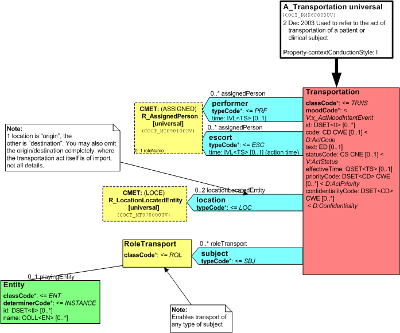
| Parent: | Patient Administration (PRPA_DM000000UV) |
This is the universal variant of A_Transportation. This CMET is used where the receiver is assumed to need all data about the planned or actual transportation of an entity (person or object) from one location to another.
Transportation - Transportation of a payload (people or material) from a location of origin to a destination location. This can be a transportation request, appointment or event.
- id - Identifier(s) for this transportation act (optional)
- code - A value specifying the mode of transportation. Examples include ambulance, private transport, public transport, on foot.
- text - A textual description of this transportation act
- statusCode - A value specifying the state of this transportation act (based on the RIM act class state-machine). Examples include pending, active, aborted, completed.
- effectiveTime - The time the transported payload is en route
- priorityCode - A code or set of codes (e.g., for routine, emergency), specifying the urgency under which the transportation act happened, can happen, is happening, or is intended to happen
- confidentialityCode - Value(s) that control the disclosure of information about this transportation act
Direct Participations
- performer - Optional association to the person(s) who transported or will transport a payload (people or material) from a location of origin to a destination location. The optional time attribute can convey the period this person transported the payload if the participation period was not for the full duration of the transport.
- escort - Optional association to the person(s) who escorted or will escort the payload during a transportation act. The optional time attribute can convey the period this person escorted the payload if the participation period was not for the full duration of the transport.
- location - Optional association to the starting and ending locations of this transportation act. A location can be specialized as origin or destination location.
- subject - Association to the entity being transported (person or material) by the transportation act
| R_LocationLocatedEntityUniversal | COCT_MT070000UV01 |
| R_AssignedPersonUniversal | COCT_MT090100UV01 |
| A_Transportation universal | COCT_MT060000UV01 |
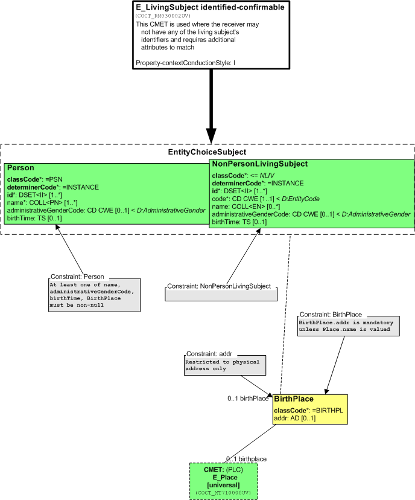
| Parent: | Administrative Registries (PRRG_DM000000UV) |
This is the identified-confirmable variant of E_LivingSubject universal. This CMET supports the case where the receiver may not have any of the living subject's identifiers and requires additional attributes to match.
Changes from Previous Version (COCT_MT030002UV01)
- Person changes conformance of name attribute from Optional [0..*] to Required [1..*]
- Person changes datatype of name attribute from BAG<EN> to BAG<PN>
- Person changes classCode attribute domain specification from <= PSN to = PSN
- Person changes determinerCode attribute domain specification from <= INSTANCE to = INSTANCE
- NonPersonLivingSubject removes quantity and strainText attributes
- NonPersonLivingSubject adds Required code attribute
- NonPersonLivingSubject changes determinerCode attribute domain specification from <= INSTANCE+KIND to = INSTANCE
- BirthPlace adds addr attribute and changes association to E_Place [universal] from Optional 1..1 to Optional 0..1.
EntityChoiceSubject - A Living Subject can be either a person or a non-person living subject.
Person - A specific human being who is or was alive.
- id - one or more identifiers for this person (mandatory)
- name - one or more names for this person (required)
- administrativeGenderCode - value representing the gender (sex) of this person. Note: this attribute does not include terms related to clinical gender which is a complex physiological, genetic and sociological concept that requires multiple observations in order to be comprehensively described.
- birthTime - The date and time this person was born. This could be an exact moment such as January 1, 1960 @ 03:00:00 EST or an approximate date such as January 1960.
NonPersonLivingSubject -A specific non-person living subject (e.g., animal, microorganism, plant) that is or was alive.
- id - one or more identifiers for this non-person living subject (mandatory)
- code - value representing the specific kind of non-person living subject the instance represents, for example animal or plant taxonomy (required)
- name - names of this non-person living subject
- administrativeGenderCode - value representing the gender (sex) of this non-person living subject. This attribute does not include terms related to clinical gender which is a complex physiological, genetic and sociological concept that requires multiple observations in order to be comprehensively described.
- birthTime - date and time this non-person living subject was born or hatched. This could be an exact moment such as January 1, 1960 @ 03:00:00 EST or an approximate date such as January 1960.
Associations
- Birth Place is the location where the focal living subject was born or hatched
Constraints
- For a Person, at least one of name, administrativeGenderCode, birthTime, or BirthPlace must be non-null
- For a NonPersonLivingSubject, at least one of name, code, administrativeGenderCode, birthTime or BirthPlace must be non-null
- For a BirthPlace, either BirthPlace.addr (physical address type) or Place.name must be non-null
| E_PlaceUniversal | COCT_MT710000UV07 |
| E_LivingSubject identified-confirmable | COCT_MT030002UV07 |
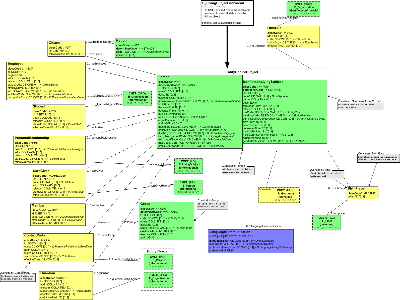
| Parent: | Administrative Registries (PRRG_DM000000UV) |
This is the universal variant of E_LivingSubject . This CMET is used where the receiver is assumed to need all data about a specific living subject.
Changes from Previous Version (COCT_MT030000UV04)
This CMET was updated to be consistent with the Patient Administration Registries DMIM. Specific changes are:
- Person changes conformance of name attribute from Optional [0..*] to Required [1..*]
- Person changes datatype of name attribute from BAG<EN> to BAG<PN>
- Person removes statusCode attribute
- Person adds telecom and addr attributes
- Person changes classCode attribute domain specification from <= PSN to = PSN
- Person changes determinerCode attribute domain specification from <= INSTANCE to = INSTANCE
- Person adds a constraint requiring that either id or name must be valued
- NonPersonLivingSubject changes determinerCode attribute domain specification from <= INSTANCE+KIND to = INSTANCE
- NonPersonLivingSubject removes quantity, statusCode and strainText attributes
- NonPersonLivingSubject changes datatype of name attribute from <SET>EN to <BAG>EN
- NonPersonLivingSubject adds code, telecom and deceasedTime attributes
- NonPersonLivingSubject adds a constraint requiring that either id or name must be valued
- EntityChoiceSubject adds new association to PersonalRelationship
- EntityChoiceSubject adds new association to CareGiver
- EntityChoiceSubject removes association to R_CoveredParty [universal]
- Citizen changes association to scoping entity from Optional 1..1 association to E_Organization to Mandatory 1..1 association to Nation
- Citizen changes classCode attribute domain specification from <= CIT to = CIT
- Student corrects datatype of statusCode attribute from SET<CS> to CS
- Student changes classCode attribute domain specification from <= STD to = STD
- Student changes association to scoping organization from E_Organization [universal] to E_Organization [informational]
- Employment renamed Employee
- Employee adds occupationCode attribute
- Employee removes jobCode attribute
- Employee changes association to scoping organization from Optional 0..1 association to E_Organization [universal] to Required 1..1 association to E_Organization [informational]
- Member changes scoping entity from an Optional 1..1 association to Entity to a Required 1..1 association to Group
- Group adds code, telecom and addr attributes
- Group removes quantity attribute
- Group adds a constraint requiring that either id or name must be valued
- Guarantor class replaced with R_Guarantor CMET
- BirthPlace adds addr attribute and changes association to E_Place [universal] from Optional 1..1 to Optional 0..1
- BirthPlace changes classCode attribute domain specification from <= BIRTHPL to = BIRTHPL
- OtherIDs adds code, statusCode and effectiveTime attributes
- OtherIDs changes id attribute from Optional [1..*] to Mandatory [1..*]
- OtherIDs changes scoping organization from Optional 0..1 association to E_Organization [universal] to Required 1..1 association E_Organization[identified/confirmable]
- ContactParty changes playing entity from an Optional 1..1 association to a choice of E_Person [identified/confirmable] or E_Organization [identified/confirmable] to a Required 1..1 association to a choice of E_Person [informational] or E_Organization [informational]
- ContactParty changes code attribute from the AdministrativeContactRoleType domain to the PersonalRelationshipRoleType domain
- ContactParty changes telecom attribute from Mandatory 1..* to Required 0..*
- ContactParty adds constraint requiring that either addr or telecom must be valued
- Guardian changes playing entity from an Optional 1..1 association to a choice of E_Person [identified/confirmable] or E_Organization [identified/confirmable] to a Required 1..1 association to a choice of E_Person [informational] or E_Organization [informational]
EntityChoiceSubject - A Living Subject can be either a person or a non-person living subject.
Person - A specific human being who is or was alive.
- id - identifiers for this person (optional)
- name - one or more names for this person (required)
- desc - textual or multimedia depiction of this person. Descriptions are meant to be shown to interested human individuals.
- telecom - telecommunication addresses for communicating with this person
- administrativeGenderCode - value representing the gender (sex) of this person. Note: this attribute does not include terms related to clinical gender which is a complex physiological, genetic and sociological concept that requires multiple observations in order to be comprehensively described.
- birthTime - date and time this person was born. This could be an exact moment such as January 1, 1960 @ 03:00:00 EST or an approximate date such as January 1960.
- deceasedInd - an indication that this person is dead
- deceasedTime - date and time this person died. This could be an exact moment such as January 1, 1960 @ 03:00:00 EST or an approximate date such as January 1960.
- multipleBirthInd - an indication that this person was part of a multiple birth
- multipleBirthOrderNumber - the order in which this person was born if part of a multiple birth
- organDonorInd - an indication that this person is a candidate to serve as an organ donor. Note: specifics of an organ donor agreement would be conveyed in a medico-legal document.
- addr - address(es) for corresponding with this person
- maritalStatusCode - value representing the domestic partnership status of this person
- educationLevelCode - value representing the highest level of education this person achieved
- disabilityCode - set of values identifying this person's disabilities
- livingArrangementCode - value specifying the housing situation of this person
- religiousAffiliationCode - value representing the primary religious preference of this person
- raceCode - set of values representing the races of this person
- ethnicGroupCode - set of values representing the ethnic groups of this person
NonPersonLivingSubject -A specific non-person living subject (e.g., animal, microorganism, plant) that is or was alive.
- id - identifiers for this non-person living subject (optional)
- code - value representing the specific kind of non-person living subject the instance represents, for example animal or plant taxonomy (required)
- name - name(s) of this non-person living subject
- desc - textual or multimedia depiction of this non-person living subject. Descriptions are meant to be shown to interested human individuals.
- existenceTime - interval of time specifying the period in which this non-person living subject physically existed
- telecom - telecommunication addresses for communicating with the focal non-person living subject
- riskCode - value representing the type of hazard or threat associated with this non-person living subject. Animals of irascible temperament may prove to be a risk to healthcare personnel.
- handlingCode - value representing special handling requirements for this non-person living subject to avoid damage to it or other entities
- administrativeGenderCode - value representing the gender (sex) of this non-person living subject. This attribute does not include terms related to clinical gender which is a complex physiological, genetic and sociological concept that requires multiple observations in order to be comprehensively described.
- birthTime - date and time this non-person living subject was born or hatched. This could be an exact moment such as January 1, 1960 @ 03:00:00 EST or an approximate date such as January 1960.
- deceasedInd - an indication that this non-person living subject is dead.
- deceasedTime - date and time this non-person living subject died. This could be an exact moment such as January 1, 1960 @ 03:00:00 EST or an approximate date such as January 1960.
- multipleBirthInd - an indication that this non-person living subject was part of a multiple birth
- multipleBirthOrderNumber - the order in which this non-person living subject was born if part of a multiple birth
- organDonorInd - an indication that this non-person living subject is a candidate to serve as an organ donor
- genderStatusCode - value representing whether the primary reproductive organs of this non-person living subject are present
Associations
- Personal Relationship is another living subject related to the focal living subject such as parent, sibling, spouse, neighbor
- Care Giver is a person who provides primary care for the focal living subject at home
- Member is the membership of the focal living subject in a Group such as a family, tribe or religious organization
- Contact Party is a person or organization that is authorized to provide or receive information about the focal living subject
- Guardian is a person or an organization that is legally responsible for the care and management of the focal living subject.
- Guarantor is a person or organization that takes financial responsibility for the health care of the focal living subject
- Birth Place is the location where the focal living subject was born or hatched
- Other IDs conveys identifiers assigned to the focal living subject in other systems
- The Person specialization of Living Subject also includes additional associations:
- Citizen - a relationship between the focal person who owes loyalty to and is entitled by birth or naturalization to the protection of a Nation
- Employee - a relationship of the focal person with an organization to receive wages or salary. The purpose of this class is to identify the type of relationship the employee has to the employer rather than the nature of the work actually performed
- Student - a relationship of the focal person to a school in which they are enrolled
- Language Communication - the language communication capability of the focal person
Constraints
- For a Person, at least one of name, administrativeGenderCode, birthTime, or BirthPlace must be non-null
- For a NonPersonLivingSubject, at least one of name, code, administrativeGenderCode, birthTime or BirthPlace must be non-null
- For a BirthPlace, either BirthPlace.addr (physical address type) or Place.name must be non-null
- For ContactParty, either addr or telecom must be non-null
- For Group, either id or name must be non-null
| E_LivingSubjectInformational | COCT_MT030007UV |
| E_PersonInformational | COCT_MT030207UV07 |
| E_PersonInformational | COCT_MT030207UV07 |
| E_OrganizationIdentified/confirmable | COCT_MT150002UV01 |
| E_OrganizationInformational | COCT_MT150007UV |
| E_OrganizationInformational | COCT_MT150007UV |
| R_GuarantorUniversal | COCT_MT670000UV04 |
| E_PlaceUniversal | COCT_MT710000UV07 |
| E_LivingSubject universal | COCT_MT030000UV09 |
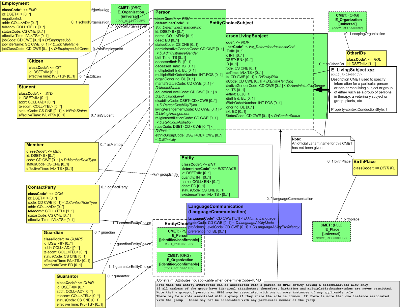
| Parent: | Administrative Registries (PRRG_DM000000UV) |
E_LivingSubject xyz
This is the [xyz???] variant of the E_LivingSubject universal CMET. This CMET defines content used to completely identify a particular person or non-person living subject (NPLS) or a group of either, such as an undifferentiated group of persons receiving clinical interventions, therapy or education, e.g., a herd of cattle receiving immunizations; 7th grade girls in a tribal school receiving HIV/AIDs education; or couples with multiple marital status in birthing classes. This variant supplies much supplementary information of use in so called "loosely-coupled" systems, where the particular person or NPLS or group of either is not necessarily known to the receiving system.
This variant differs from the universal in two ways: (1) it does not include an association to the R_CoveredParty CMET because it is included in the release 2 version of the R_CoveredParty CMET, which would result in self-reference; and (2) the determinerCode for both the Person entity and the NPLS entity allows both INSTANCE and KIND. The universal variant supports INSTANCE and KIND on the NPLS, not the Person entity. The PRPA DM000000 does not support KIND on either entity.
| E_PersonIdentified/confirmable | COCT_MT030202UV07 |
| E_OrganizationUniversal | COCT_MT150000UV02 |
| E_OrganizationUniversal | COCT_MT150000UV02 |
| E_OrganizationIdentified/confirmable | COCT_MT150002UV01 |
| E_PlaceUniversal | COCT_MT710000UV07 |
| E_LivingSubject xyz | COCT_MT030007UV |
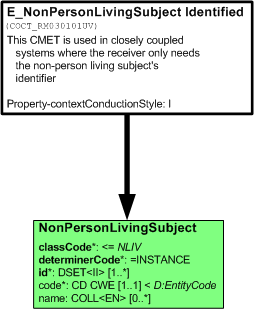
| Parent: | Administrative Registries (PRRG_DM000000UV) |
This is the identified variant of E_NonPersonLivingSubject universal. This CMET supports the case of closely coupled systems where the receiver only needs the non-person living subject's identifier.
Changes from Previous Version (COCT_RM030101UV01)
- NonPersonLivingSubject changes determinerCode attribute domain specification from <= INSTANCE to = INSTANCE
- NonPersonLivingSubject adds Requred 1..1 code attribute
- NonPersonLivingSubject changes name attribute datatype from SET<EN> to BAG<EN>
- NonPersonLivingSubject removes quantity attribute
NonPersonLivingSubject -A specific non-person living subject (e.g., animal, microorganism, plant).
- id - one or more identifiers for this non-person living subject (mandatory)
- code - value representing the specific kind of non-person living subject the instance represents, for example animal or plant taxonomy (required)
- name - names of this non-person living subject
| E_NonPersonLivingSubject identified | COCT_MT030101UV07 |
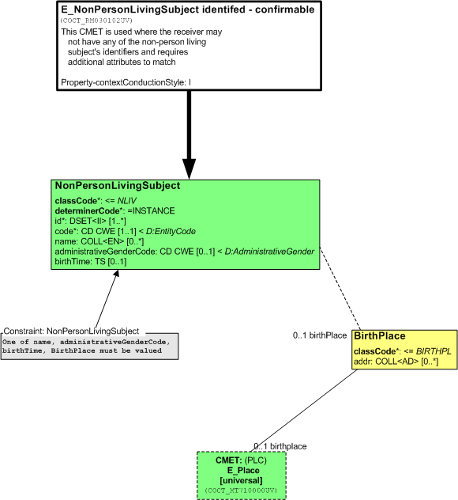
| Parent: | Administrative Registries (PRRG_DM000000UV) |
This is the identified-confirmable variant of E_NonPersonLivingSubject universal. This CMET supports the case where the receiver may not have any of the person's identifiers and requires additional attributes to match.
Changes from Previous Version (COCT_RM030102UV01)
- NonPersonLivingSubject changes determinerCode attribute domain specification from <= INSTANCE+KIND to = INSTANCE
- NonPersonLivingSubject adds Required 1..1 code attribute
- NonPersonLivingSubject removes quantity and strainText attributes
- NonPersonLivingSubject changes datatype of name attribute from <SET>EN to <BAG>EN
- BirthPlace adds addr attribute and changes association to E_Place [universal] from Optional 1..1 to Optional 0..1
NonPersonLivingSubject -A specific non-person living subject (e.g., animal, microorganism, plant).
- id - one or more identifiers for this non-person living subject (required)
- code - value representing the specific kind of non-person living subject the instance represents, for example animal or plant taxonomy (required)
- name - names of this non-person living subject
- administrativeGenderCode - value representing the gender (sex) of this non-person living subject. This attribute does not include terms related to clinical gender which is a complex physiological, genetic and sociological concept that requires multiple observations in order to be comprehensively described.
- birthTime - date and time this non-person living subject was born or hatched. This could be an exact moment such as January 1, 1960 @ 03:00:00 EST or an approximate date such as January 1960.
- Birth Place - location where the focal non-person living subject was born or hatched
Constraints
- A name, administrativeGenderCode, birthtime or BirthPlace must be non-null
| E_PlaceUniversal | COCT_MT710000UV07 |
| E_NonPersonLivingSubject identified-confirmable | COCT_MT030102UV07 |
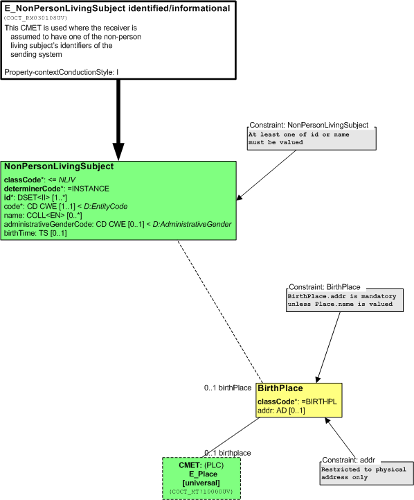
| Parent: | Administrative Registries (PRRG_DM000000UV) |
This is the identified/informational variant of E_NonPersonLivingSubject universal. This CMET supports the case where the receiver is assumed to have one of the non-person living subject's identifiers of the sending system.
NonPersonLivingSubject -A specific non-person living subject (e.g., animal, microorganism, plant).
- id - one or more identifiers for this non-person living subject (mandatory)
- code - value representing the specific kind of non-person living subject the instance represents, for example animal or plant taxonomy (required)
- name - names of this non-person living subject
- administrativeGenderCode - value representing the gender (sex) of this non-person living subject. This attribute does not include terms related to clinical gender which is a complex physiological, genetic and sociological concept that requires multiple observations in order to be comprehensively described.
- birthTime - date and time this non-person living subject was born or hatched. This could be an exact moment such as January 1, 1960 @ 03:00:00 EST or an approximate date such as January 1960.
- Birth Place - location where the focal non-person living subject was born or hatched
Constraints
- Either an id or a name must be valued in the NonPersonLivingSubject
- In a BirthPlace is sent then either the Place.name or BirthPlace.addr (must be a physical address) must be valued
| E_PlaceUniversal | COCT_MT710000UV07 |
| E_NonPersonLivingSubject identified-informational | COCT_MT030108UV07 |
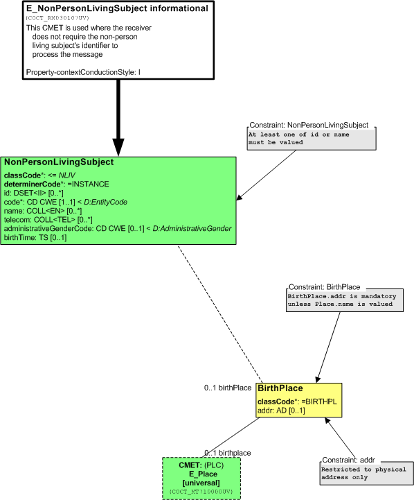
| Parent: | Administrative Registries (PRRG_DM000000UV) |
This is the informational variant of E_NonPersonLivingSubject universal. This CMET is used where the receiver is assumed not to need the living subject's identifier to process the message.
NonPersonLivingSubject -A specific non-person living subject (e.g., animal, microorganism, plant).
- id - identifiers for this non-person living subject (optional)
- code - value representing the specific kind of non-person living subject the instance represents, for example animal or plant taxonomy (required)
- name - names of this non-person living subject
- telecom - telecommunication addresses for communicating with this non-person living subject
- administrativeGenderCode - value representing the gender (sex) of this non-person living subject. This attribute does not include terms related to clinical gender which is a complex physiological, genetic and sociological concept that requires multiple observations in order to be comprehensively described.
- birthTime - date and time this non-person living subject was born or hatched. This could be an exact moment such as January 1, 1960 @ 03:00:00 EST or an approximate date such as January 1960.
- Birth Place - location where the focal non-person living subject was born or hatched
Constraints
- Either an id or a name must be valued in the NonPersonLivingSubject
- In a BirthPlace is sent then either the Place.name or BirthPlace.addr (must be a physical address) must be valued
| E_PlaceUniversal | COCT_MT710000UV07 |
| E_NonPersonLivingSubject informational | COCT_MT030107UV07 |
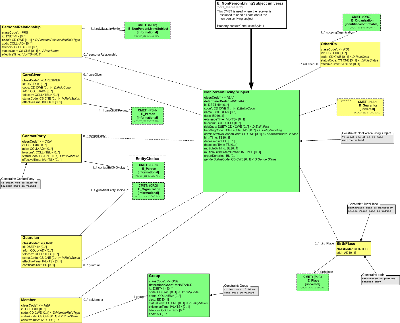
| Parent: | Administrative Registries (PRRG_DM000000UV) |
The universal variant of E_NonPersonLivingSubject. This CMET is used where the receiver is assumed to need all data about a particular non-person living subject such as veterinary subject, plant, etc.
Changes from Previous Version (COCT_RM030100UV01)
This CMET was updated to be consistent with the Patient Administration Registries DMIM. Specific changes are:
- NonPersonLivingSubject changes determinerCode attribute domain specification from <= INSTANCE+KIND to = INSTANCE
- NonPersonLivingSubject removes quantity, statusCode and strainText attributes
- NonPersonLivingSubject changes datatype of name attribute from <SET>EN to <BAG>EN
- NonPersonLivingSubject adds code, telecom and deceasedTime attributes
- NonPersonLivingSubject adds association to PersonalRelationship
- NonPersonLivingSubject adds association to CareGiver
- NonPersonLivingSubject adds a constraint requiring that id or name must be valued
- NonPersonLivingSubject removes association to R_CoveredParty [universal]
- Member changes scoping entity from an Optional 1..1 association to Entity to a Required 1..1 association to Group
- Group adds code, telecom and addr attributes
- Group removes quantity attribute
- Group adds a constraint requiring that id or name must be valued
- Guarantor class replaced with R_Guarantor CMET
- BirthPlace adds addr attribute and changes association to E_Place [universal] from Optional 1..1 to Optional 0..1
- OtherIDs adds code, statusCode and effectiveTime attributes
- OtherIDs changes id attribute from Optional [1..*] to Mandatory [1..*]
- OtherIDs changes scoping organization from an Optional 0..1 association to E_Organization [universal] to a Required 1..1 association to E_Organization[identified/confirmable]
- ContactParty changes playing entity from an Optional 1..1 association to a choice between E_Person [identified/confirmable] or E_Organization [identified/confirmable] to a Required 1..1 association to a choice between E_Person [informational] or E_Organization [informational]
- ContactParty removes code attribute
- ContactParty changes telecom attribute from Mandatory 1..* to Required 0..*
- ContactParty adds constraint requiring that either addr or telecom must be valued
- Guardian changes playing entity from an Optional 1..1 association to a choice of E_Person [identified/confirmable] or E_Organization [identified/confirmable] to a Required 1..1 association to a choice of E_Person [informational] or E_Organization [informational]
- Guardian changes classCode attribute domain specification from <= GUAR to = GUAR
NonPersonLivingSubject -A specific non-person living subject (e.g., animal, microorganism, plant) that is or was alive.
- id - identifiers for this non-person living subject (optional)
- code - value representing the specific kind of non-person living subject the instance represents, for example animal or plant taxonomy (required)
- name - names of this non-person living subject
- desc - textual or multimedia depiction of this non-person living subject. Descriptions are meant to be shown to interested human individuals.
- existenceTime - interval of time specifying the period in which this non-person living subject physically existed
- telecom - telecommunication addresses for communicating with this non-person living subject
- riskCode - value representing the type of hazard or threat associated with this non-person living subject. Animals of irascible temperament may prove to be a risk to healthcare personnel.
- handlingCode - value representing special handling requirements for this non-person living subject to avoid damage to it or other entities
- administrativeGenderCode - value representing the gender (sex) of this non-person living subject. This attribute does not include terms related to clinical gender which is a complex physiological, genetic and sociological concept that requires multiple observations in order to be comprehensively described.
- birthTime - date and time this non-person living subject was born or hatched. This could be an exact moment such as January 1, 1960 @ 03:00:00 EST or an approximate date such as January 1960.
- deceasedInd - an indication that this non-person living subject is dead.
- deceasedTime - date and time this non-person living subject died. This could be an exact moment such as January 1, 1960 @ 03:00:00 EST or an approximate date such as January 1960.
- multipleBirthInd - an indication that this non-person living subject was part of a multiple birth
- multipleBirthOrderNumber - The order in which this non-person living subject was born if part of a multiple birth
- organDonorInd - an indication that this non-person living subject is a candidate to serve as an organ donor
- genderStatusCode - value representing whether the primary reproductive organs of this non-person living subject are present
Associations
- Personal Relationship is another non-person living subject related to the focal living subject such as parent, sibling, neighbor
- Care Giver is a person who provides primary care for the focal non-person living subject at home
- Contact Party is a person or organization that is authorized to provide or receive information about the focal non-person living subject
- Guardian is a person or an organization that is legally responsible for the care and management of the focal non-person living subject.
- Member is the membership of the focal non-person living subject in a Group
- Other IDs conveys identifiers assigned to the focal non-person living subject in other systems
- Guarantor is a person or organization that takes financial responsibility for the health care of the focal non-person living subject
- Birth Place is the location where the focal non-person living subject was born or hatched
Constraints
- For NonPersonLivingSubject, either id or name must be non-null
- For BirthPlace, either BirthPlace.addr (physical address type) or Place.name must be non-null
- For Contact Party, either addr or telecom must be non-null
- For Group, either id or name must be non-null
| E_NonPersonLivingSubjectInformational | COCT_MT030107UV07 |
| E_PersonInformational | COCT_MT030207UV07 |
| E_PersonInformational | COCT_MT030207UV07 |
| E_OrganizationIdentified/confirmable | COCT_MT150002UV01 |
| E_OrganizationInformational | COCT_MT150007UV |
| R_GuarantorUniversal | COCT_MT670000UV04 |
| E_PlaceUniversal | COCT_MT710000UV07 |
| E_NonPersonLivingSubject universal | COCT_MT030100UV09 |
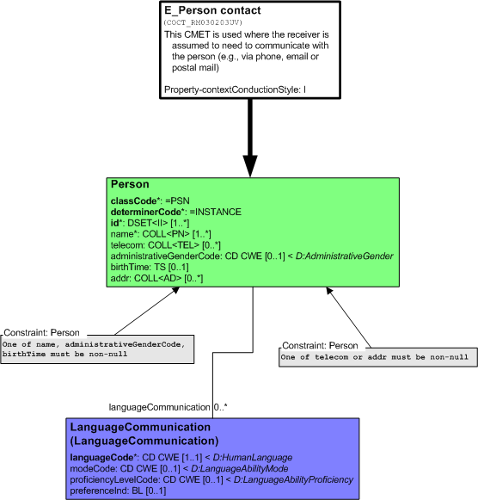
| Parent: | Administrative Registries (PRRG_DM000000UV) |
This is the contact variant of E_Person universal. This CMET supports the case where the receiver is assumed to need to communicate with the person (e.g., via phone, email or postal mail).
Person - A specific human being
- id - one or more identifiers for this person (mandatory)
- name - one or more names for this person (required)
- telecom - telecommunication addresses for communicating with this person
- administrativeGenderCode - value representing the gender (sex) of this person. Note: this attribute does not include terms related to clinical gender which is a complex physiological, genetic and sociological concept that requires multiple observations in order to be comprehensively described.
- birthTime - date and time this person was born. This could be an exact moment such as January 1, 1960 @ 03:00:00 EST or an approximate date such as January 1960.
- addr - address(es) for corresponding with this person
- Language Communication - language communication capability of the person
Constraints
- The Person name, administrativeGenderCode or birthTime must be non-null.
- Either telecom or addr must be non-null
| E_Person contact | COCT_MT030203UV07 |
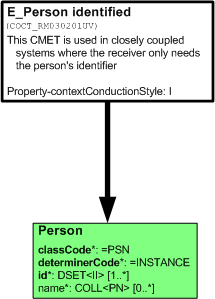
| Parent: | Administrative Registries (PRRG_DM000000UV) |
This is the identified variant of E_Person universal. This CMET supports the case of closely coupled systems where the receiver only needs the person's identifier
Person - A specific human being
- id - one or more identifiers for this person (mandatory)
- name - names of this person (required)
| E_Person identified | COCT_MT030201UV07 |
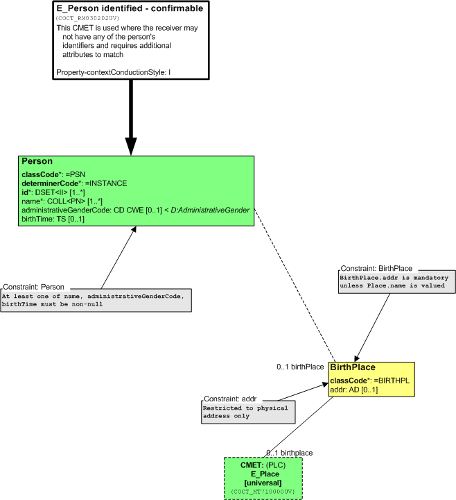
| Parent: | Administrative Registries (PRRG_DM000000UV) |
This is the identified-confirmable variant of E_Person universal. This CMET supports the case where the receiver may not have any of the person's identifiers and requires additional attributes to match
Changes from Previous Version (COCT_RM030202UV01)
- Person changes classCode attribute domain specification from <= PSN to = PSN
- Person changes determinerCode attribute domain specification from <= INSTANCE to = INSTANCE
- Person changes name attribute conformance from optional [0..*] to required [1..*]
- Person changes name attribute datatype from BAG<EN> to BAG<PN>
- BirthPlace adds addr attribute and changes association to playing entity from an Optional 1..1 association to Place to an Optional 0..1 association to E_Place [universal]
Person - A specific human being
- id - one or more identifiers for this person (mandatory)
- name - one or more names for this person (required)
- administrativeGenderCode - value representing the gender (sex) of this person. Note: this attribute does not include terms related to clinical gender which is a complex physiological, genetic and sociological concept that requires multiple observations in order to be comprehensively described.
- birthTime - date and time this person was born. This could be an exact moment such as January 1, 1960 @ 03:00:00 EST or an approximate date such as January 1960.
- Birth Place is the location where the focal person was born
Constraints
- The Person name, administrativeGenderCode or birthTime must be non-null
- For BirthPlace, either BirthPlace.addr (physical address) or Place.name must be non-null
| E_PlaceUniversal | COCT_MT710000UV07 |
| E_Person identified-confirmable | COCT_MT030202UV07 |
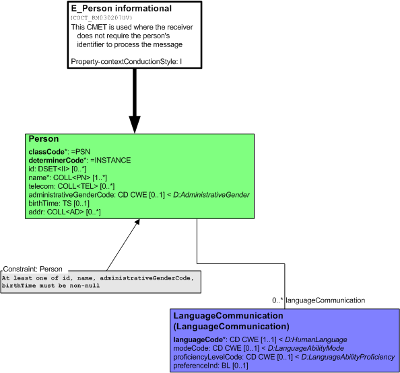
| Parent: | Administrative Registries (PRRG_DM000000UV) |
This is the informational variant of E_Person universal. This CMET is used where the receiver is assumed not to need the person's identifier to process the message.
Person - A specific human being
- id - identifiers for this person (optional)
- name - one or more names for this person (required)
- telecom - telecommunication addresses for communicating with this person
- administrativeGenderCode - value representing the gender (sex) of this person. Note: this attribute does not include terms related to clinical gender which is a complex physiological, genetic and sociological concept that requires multiple observations in order to be comprehensively described.
- birthTime - date and time this person was born. This could be an exact moment such as January 1, 1960 @ 03:00:00 EST or an approximate date such as January 1960.
- addr - addresses for corresponding with this person
- Language Communication - language communication capability of the person
Constraints
- The Person id, name, administrativeGenderCode or birthTime must be non-null
| E_Person informational | COCT_MT030207UV07 |
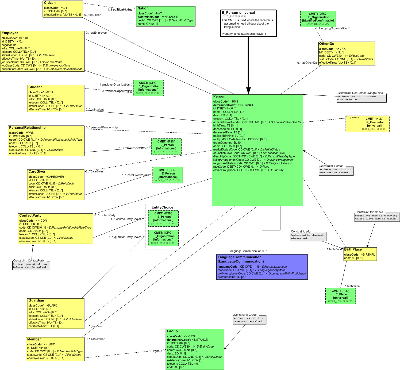
| Parent: | Administrative Registries (PRRG_DM000000UV) |
This is the universal variant of E_Person. This CMET supports the case where the receiver is assumed to need all data about a person.
Changes from Previous Version (COCT_RM030200UV01)
This CMET was updated to be consistent with the Patient Administration Registries DMIM. Specific changes are:
- Person changes classCode attribute domain specification from <= PSN to = PSN
- Person changes determinerCode attribute domain specification from <= INSTANCE to = INSTANCE
- Person changes conformance of name attribute from Optional [0..*] to Required [1..*]
- Person changes datatype of name attribute from BAG<EN> to BAG<PN>
- Person removes statusCode attribute
- Person adds telecom and addr attributes
- Person adds association to PersonalRelationship
- Person adds association to CareGiver
- Person removes association to R_CoveredParty [universal]
- Citizen changes classCode attribute domain specification from <= CIT to = CIT
- Citizen changes association to scoping entity from Optional 1..1 association to E_Organization [universal] to Mandatory 1..1 association to Nation
- Student changes classCode attribute domain specification from <= STD to = STD
- Student changes association to scoping organization from E_Organization [universal] to E_Organization [informational]
- Employment renamed Employee
- Employee adds occupationCode attribute
- Employee removes jobCode attribute
- Employee changes association to scoping organization from Optional 0..1 association to E_Organization [universal] to Required 1..1 association to E_Organization [informational]
- Member changes scoping entity from an Optional 1..1 association to Entity to a Required 1..1 association to Group
- Group adds code, telecom and addr attributes
- Group removes quantity attribute
- Guarantor class replaced with R_Guarantor CMET
- BirthPlace adds addr attribute and changes association to E_Place [universal] from Optional 1..1 to Optional 0..1
- OtherIDs adds code, statusCode and effectiveTime attributes
- OtherIDs changes id attribute from Optional [1..*] to Mandatory [1..*]
- OtherIDs changes scoping organization from E_Organization [universal] to E_Organization[identified/confirmable]
- ContactParty changes playing entity from an Optional 1..1 association to a choice between E_Person [identified/confirmable] or E_Organization [identified/confirmable] to a Required 1..1 association to a choice between E_Person [informational] or E_Organization [informational]
- ContactParty changes code attribute from the AdministrativeContactRoleType domain to the PersonalRelationshipRoleType domain
- ContactParty changes telecom attribute from Mandatory 1..* to Required 0..*
- ContactParty adds constraint requiring that either addr or telecom must be valued
- Guardian changes classCode attribute domain specification from <= GUAR to = GUAR
- Guardian changes playing entity from an Optional 1..1 association to a choice of E_Person [identified/confirmable] or E_Organization [identified/confirmable] to a Required 1..1 association to a choice of E_Person [informational] or E_Organization [informational]
Person - A specific human being who is or was alive.
- id - identifiers for this person (optional)
- name - one or more names for this person (required)
- desc - textual or multimedia depiction of this person. Descriptions are meant to be shown to interested human individuals.
- telecom - telecommunication addresses for communicating with this person
- administrativeGenderCode - value representing the gender (sex) of this person. Note: this attribute does not include terms related to clinical gender which is a complex physiological, genetic and sociological concept that requires multiple observations in order to be comprehensively described.
- birthTime - date and time this person was born. This could be an exact moment such as January 1, 1960 @ 03:00:00 EST or an approximate date such as January 1960.
- deceasedInd - an indication that this person is dead
- deceasedTime - date and time this person died. This could be an exact moment such as January 1, 1960 @ 03:00:00 EST or an approximate date such as January 1960.
- multipleBirthInd - an indication that this person was part of a multiple birth
- multipleBirthOrderNumber - order in which this person was born if part of a multiple birth
- organDonorInd - an indication that this person is a candidate to serve as an organ donor. Note: specifics of an organ donor agreement would be conveyed in a medico-legal document.
- addr - addresses for corresponding with this person
- maritalStatusCode - value representing the domestic partnership status of this person
- educationLevelCode - value representing the highest level of education this person achieved
- disabilityCode - set of values identifying this person's disabilities
- livingArrangementCode - value specifying the housing situation of this person
- religiousAffiliationCode - value representing the primary religious preference of this person
- raceCode - set of values representing the races of this person
- ethnicGroupCode - set of values representing the ethnic groups of this person
Associations
- Citizen - a relationship between the focal person who owes loyalty to and is entitled by birth or naturalization to the protection of a Nation
- Employee - a relationship of the focal person with an organization to receive wages or salary. The purpose of this class is to identify the type of relationship the employee has to the employer rather than the nature of the work actually performed.
- Student - a relationship of the focal person to a school in which they are enrolled
- Personal Relationship is another person related to the focal person such as parent, sibling, spouse, neighbor
- Care Giver is a person who provides primary care for the focal person at home
- Contact Party is a person or organization that is authorized to provide or receive information about the focal person
- Guardian is a person or an organization that is legally responsible for the care and management of the focal person
- Member is the membership of the focal person in a Group such as a family, tribe or religious organization
- Other IDs conveys identifiers assigned to the focal person in other systems
- Guarantor is a person or organization that takes financial responsibility for the health care of the focal person
- Birth Place is the location where the focal person was born
- Language Communication - the language communication capability of the focal person
Constraints
- For Person, at least one of id or name must be non-null
- For BirthPlace, either BirthPlace.addr (physical address) or Place.name must be non-null
- For ContactParty, either addr or telecom must be non-null
- For Group, either id or name must be non-null
| E_PersonInformational | COCT_MT030207UV07 |
| E_PersonInformational | COCT_MT030207UV07 |
| E_PersonInformational | COCT_MT030207UV07 |
| E_OrganizationIdentified/confirmable | COCT_MT150002UV01 |
| E_OrganizationInformational | COCT_MT150007UV |
| E_OrganizationInformational | COCT_MT150007UV |
| R_GuarantorUniversal | COCT_MT670000UV04 |
| E_PlaceUniversal | COCT_MT710000UV07 |
| E_Person universal | COCT_MT030200UV09 |
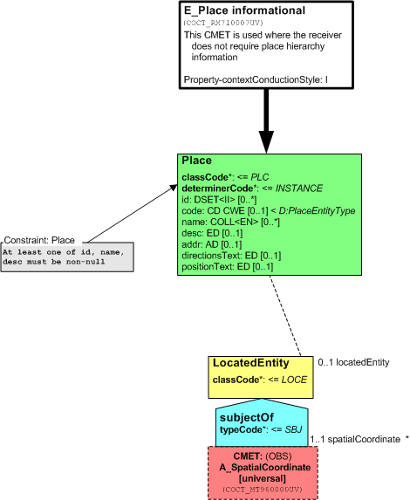
| Parent: | Administrative Registries (PRRG_DM000000UV) |
This is the informational variant of E_Place universal. This CMET is used where the receiver is assumed not to need the place identifier or place hierarchy information to process the message.
Place - a bounded physical place or site with its contained structures, if any. May be natural or man-made.
- id - identifiers for this physical place (optional)
- code - value further specifying the type of place drawn from the PlaceEntityType domain. Examples include bed location, room location, floor location, wing location, and building location.
- name - non-unique textual identifiers or monikers for this place
- desc - textual or multimedia depiction of this place. Note: descriptions are meant to be shown to interested human individuals.
- addr - physical address of this place
- directionsText - free text note that carries information related to a site that is useful for entities accessing that site. For example, it could include information useful to people visiting the location such as "Last house on the right" or "If owner not present, check whereabouts with neighbor down the road".
- positionText - text reference that locates the site within a mapping scheme, for example, map coordinates for US Geological Survey maps
- A_SpatialCoordinate - The position of a Place can be specified by a spatial coordinate observation
Constraints
- For Place, either id or name must be non-null
| A_SpatialCoordinateUniversal | COCT_MT960000UV05 |
| E_Place informational | COCT_MT710007UV07 |
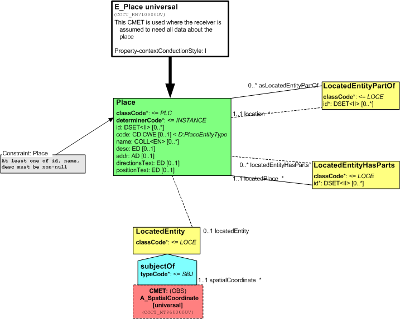
| Parent: | Administrative Registries (PRRG_DM000000UV) |
This CMET is the universal variant of E_Place. This CMET is used to describe a place, which can be recursively described within a containing place, and/or contain other places. The universal variant is used where the receiver is assumed to need all data about the place.
Changes from Previous Version (COCT_RM710000UV01)
- Place adds the addr attribute
- Place removes the gpsText attribute and replaces it with an Optional 0..1 association to A_SpatialCoordinate [universal] CMET.
- LocatedEntityPartOf changes conformance for id attribute from Required 0..1 to Mandatory 1..*
- LocatedEntityHasParts changes conformance for id attribute from Required 0..1 to Mandatory 1..*
Place - a bounded physical place or site with its contained structures, if any. May be natural or man-made.
- id - identifiers for this physical place
- code - value further specifying the type of place drawn from the PlaceEntityType domain. Examples include bed location, room location, floor location, wing location, and building location.
- name - non-unique textual identifiers or monikers for this place
- desc - textual or multimedia depiction of this place. Note: descriptions are meant to be shown to interested human individuals.
- addr - physical address of this place
- directionsText - free text note that carries information related to a site that is useful for entities accessing that site. For example, it could include information useful to people visiting the location such as "Last house on the right" or "If owner not present, check whereabouts with neighbor down the road".
- positionText - text reference that locates the site within a mapping scheme, for example, map coordinates for US Geological Survey maps
LocatedEntityHasParts - association of a place to other places contained within it. This supports a hierarchy of places, for example a building wing (scoping entity) contains rooms (playing entity).
LocatedEntityPartOf - association of a place to other places that contain it. This supports a hierarchy of places, for example a bed location (playing entity) located within a room (scoping entity)
A_SpatialCoordinate - The position of a Place can be specified by a spatial coordinate observation.
Constraints
- For Place, either id or name must be non-null
| A_SpatialCoordinateUniversal | COCT_MT960000UV05 |
| E_Place universal | COCT_MT710000UV07 |
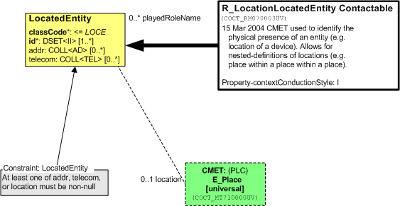
| Parent: | Administrative Registries (PRRG_DM000000UV) |
This is the contact variant of R_LocationLocatedEntity universal. This CMET supports the case where the receiver is assumed to need to communicate the located entity at a particular place (e.g., via phone, email or postal mail).
LocatedEntity - Relates an entity (player) to a Place (scoper) at which it is located
- id - one or more identifiers for this located entity (mandatory)
- addr - addresses for the focal entity at this location
- telecom - telecommunication addresses for the focal entity at this location
- E_Place Universal - a bounded physical place or site with its contained structures, if any. May be natural or man-made. The geographic position of a place may or may not be constant. The place can be recursively described within a containing place and/or contain other places. The place can be located via Spatial Coordinates.
Constraints
- Either an addr or telecom must be non-null
| E_PlaceUniversal | COCT_MT710000UV07 |
| R_LocationLocatedEntity contact | COCT_MT070003UV02 |

| Parent: | Administrative Registries (PRRG_DM000000UV) |
This is the identified variant of R_LocationLocatedEntity universal. This CMET supports the case of closely coupled systems where the receiver only needs an identifier.
LocatedEntity - Relates an entity (player) to a Place (scoper) at which it is located
- id - one or more identifiers for this located entity (mandatory)
| R_LocationLocatedEntity identified | COCT_MT070001UV02 |
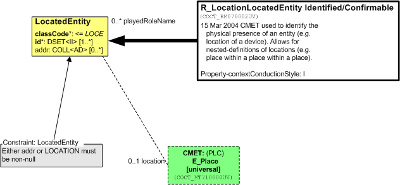
| Parent: | Administrative Registries (PRRG_DM000000UV) |
This is the identified-confirmable variant of R_LocationLocatedEntity universal. This CMET supports the use case where the receiver may not have any of the LocatedEntity's identifiers and requires additional attributes to match.
LocatedEntity - Relates an entity (player) to a Place (scoper) at which it is located
- id - one or more identifiers for this located entity (mandatory)
- addr - addresses for the focal entity at this location
- E_Place Universal - a bounded physical place or site with its contained structures, if any. May be natural or man-made. The geographic position of a place may or may not be constant. The place can be recursively described within a containing place and/or contain other places. The place can be located via Spatial Coordinates.
Constraints
- Either LocatedEntity.addr or E_Place must be non-null
| E_PlaceUniversal | COCT_MT710000UV07 |
| R_LocationLocatedEntity identified-confirmable | COCT_MT070002UV02 |
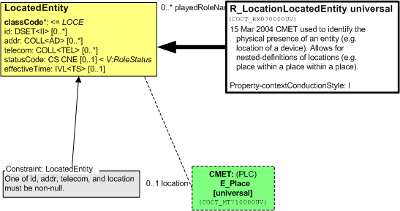
| Parent: | Administrative Registries (PRRG_DM000000UV) |
Used to identify a particular location. (I.e. bed or a nursing station, floor, building) in a Healthcare Facility. May be scoped or involved in a participation. Allows for nested definitions, i.e., place within place within place.
LocatedEntity - Relates an entity (player) to a Place (scoper) at which it is located
- id - identifiers for this located entity (optional)
- addr - addresses for the focal entity at this location
- telecom - telecommunication addresses for the focal entity at this location
- statusCode - value specifying the state of this located entity role (based on the RIM Role class state-machine), for example active, suspended, terminated
- effectiveTime - interval of time specifying the period during which the focal entity is at the specified location, if such time is applicable and known
- E_Place Universal - a bounded physical place or site with its contained structures, if any. May be natural or man-made. The geographic position of a place may or may not be constant. The place can be recursively described within a containing place and/or contain other places. The place can be located via Spatial Coordinates.
Constraints
- Either an id, addr, telecom or E_Place must be non-null
| E_PlaceUniversal | COCT_MT710000UV07 |
| R_LocationLocatedEntity universal | COCT_MT070000UV01 |
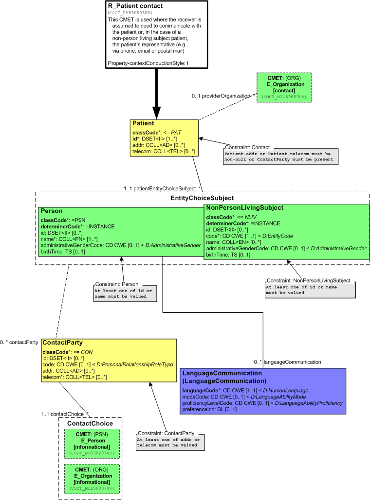
| Parent: | Administrative Registries (PRRG_DM000000UV) |
This is the contact variant of R_Patient universal. This CMET is used where the receiver is assumed to need to communicate with the patient or the patient's representative (e.g., via phone, email or postal mail).
Changes from Previous Version (COCT_RM500003UV04)
This CMET was updated to be consistent with the Patient Administration Registries DMIM. Specific changes are:
- Person changes classCode attribute domain specification from <= PSN to = PSN
- Person changes determinerCode attribute domain specification from <= INSTANCE to = INSTANCE
- Patient changes id attribute cardinality from [0..*] to [1..*]
- Person changes name attribute conformance from optional [0..*] to required [1..*]
- Patient changes conformance of association to EntityChoiceSubject from optional [0..1] to required [1..1]
- Person changes name attribute datatype from BAG<EN> to BAG<PN>
- Person adds association to LanguageCommunication to be consistent with E_Person contact
- NonPersonLivingSubject changes determinerCode attribute domain specification from <= INSTANCE to = INSTANCE
- NonPersonLivingSubject adds Required code attribute
- NonPersonLivingSubject removes quantity and strainText attributes
- ContactParty changes playing entity from an Optional 0..1 association to a choice of ContactPerson or ContactOrganization to a Required 1..1 association to a choice of E_Person [informational] or E_Organization [informational]
- ContactParty adds code attribute tied to the PersonalRelationshipRoleType domain
- ContactParty adds constraint requiring that either addr or telecom must be valued
- Changed constraint requiring either Patient.addr or Patient.telecom be valued to "Patient.addr or Patient.telecom must be non-null or ContactParty must be present"
Patient - a role played by a living subject (either a Person or a Non-person Living Subject) as a recipient or potential recipient of health care services from a healthcare provider Organization (represented by E_Organization [contact])
- id - one or more identifiers for this patient (mandatory)
- addr - addresses for corresponding with the focal living subject in their role as patient
- telecom - telecommunication addresses for communicating with the focal living subject in their role as patient
EntityChoiceSubject - A Living Subject can be either a person or a non-person living subject.
- Person - A specific human being who is or was alive
- id - identifiers for this person (optional)
- name - one or more names for this person (required)
- administrativeGenderCode - value representing the gender (sex) of this person. Note: this attribute does not include terms related to clinical gender which is a complex physiological, genetic and sociological concept that requires multiple observations in order to be comprehensively described.
- birthTime - date and time this person was born. This could be an exact moment such as January 1, 1960 @ 03:00:00 EST or an approximate date such as January 1960.
- Language Communication - the language communication capability of the focal person
- NonPersonLivingSubject -A specific non-person living subject (e.g., animal, microorganism, plant) that is or was alive
- id - identifiers for this non-person living subject (optional)
- code - value representing the specific kind of non-person living subject the instance represents, for example animal or plant taxonomy (required)
- name - names of this non-person living subject (optional)
- administrativeGenderCode - value representing the gender (sex) of this non-person living subject. This attribute does not include terms related to clinical gender which is a complex physiological, genetic and sociological concept that requires multiple observations in order to be comprehensively described.
- birthTime - date and time this non-person living subject was born or hatched. This could be an exact moment such as January 1, 1960 @ 03:00:00 EST or an approximate date such as January 1960.
- ContactParty - a person or organization that is authorized to provide information about the focal living subject (patient)
- id - identifiers for this contact party relationship (optional)
- code - value specifying the type of relationship a contact person has to the patient form whom they are a contact; for example, spouse, parent, neighbor
- addr - addresses for corresponding with this contact party
- telecom - telecommunications addresses for communicating with this contact party
Constraints
- Patient.addr or Patient.telecom must be non-null or ContactParty must be present
- EntityChoice (Person or NonPersonLivingSubject) must have id or name non-null
- For ContactParty, either addr or telecom must be non-null
| E_PersonInformational | COCT_MT030207UV07 |
| E_OrganizationContact | COCT_MT150003UV03 |
| E_OrganizationInformational | COCT_MT150007UV |
| R_Patient contact | COCT_MT050003UV09 |
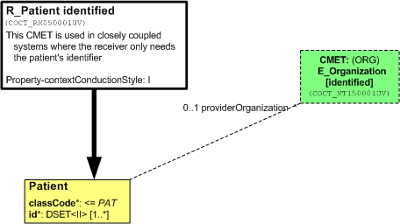
| Parent: | Administrative Registries (PRRG_DM000000UV) |
This is the identified variant of R_Patient universal. This CMET supports the case of closely coupled systems where the receiver only needs the patient's identifier
Patient - a role played by a living subject as a recipient or potential recipient of health care services from a healthcare provider Organization (represented by E_Organization [identified])
- id - one or more identifiers for this patient (mandatory)
| E_OrganizationIdentified | COCT_MT150001UV01 |
| R_Patient identified | COCT_MT050001UV07 |
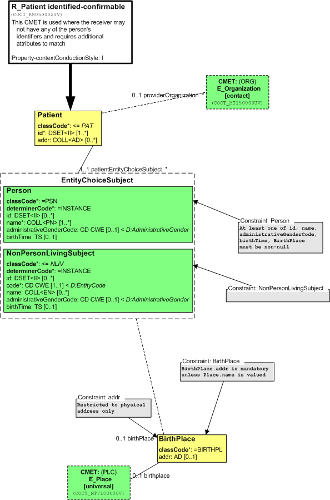
| Parent: | Administrative Registries (PRRG_DM000000UV) |
This is the identified-confirmable variant of R_Patient universal This CMET supports the case where the receiver may not have any of the patient's identifiers and requires additional attributes to match
Changes from Previous Version (COCT_RM050002UV04)
- Patient changes conformance for association to EntityChoiceSubject from optional [0..1] to required [1..1]
- EntityChoiceSubject adds association to BirthPlace
- Person changes classCode attribute domain specification from <= PSN to = PSN
- Person changes determinerCode attribute domain specification from <= INSTANCE to = INSTANCE
- Person changes name attribute conformance from Optional [0..*] to Required [1..*]
- Person changes name attribute datatype from BAG<EN> to BAG<PN>
- Person adds a constraint requiring that at least one of id, name, administrativeGenderCode, birthTime, BirthPlace be non-null
- NonPersonLivingSubject changes determinerCode attribute domain specification from <= INSTANCE to = INSTANCE
- NonPersonLivingSubject adds Required code attribute
- NonPersonLivingSubject adds a constraint requiring that at least one of id, name, administrativeGenderCode, birthTime, BirthPlace be non-null
Patient - a role played by a living subject (either a Person or a Non-person Living Subject) as a recipient or potential recipient of health care services from a healthcare provider Organization (represented by E_Organization [contact])
- id - one or more identifiers for this patient (mandatory)
- addr - addresses for corresponding with the focal living subject in their role as patient
EntityChoiceSubject - A Patient can be either a person or a non-person living subject.
- Person - A specific human being who is or was alive
- id - identifiers for this person (optional)
- name - one or more names for this person (required)
- administrativeGenderCode - value representing the gender (sex) of this person. Note: this attribute does not include terms related to clinical gender which is a complex physiological, genetic and sociological concept that requires multiple observations in order to be comprehensively described.
- birthTime - date and time this person was born. This could be an exact moment such as January 1, 1960 @ 03:00:00 EST or an approximate date such as January 1960.
- NonPersonLivingSubject -A specific non-person living subject (e.g., animal, microorganism, plant) that is or was alive
- id - identifiers for this non-person living subject (optional)
- code - value representing the specific kind of non-person living subject the instance represents, for example animal or plant taxonomy (required)
- name - names of this non-person living subject
- administrativeGenderCode - value representing the gender (sex) of this non-person living subject. This attribute does not include terms related to clinical gender which is a complex physiological, genetic and sociological concept that requires multiple observations in order to be comprehensively described.
- birthTime - date and time this non-person living subject was born or hatched. This could be an exact moment such as January 1, 1960 @ 03:00:00 EST or an approximate date such as January 1960.
Birth Place is the location where the focal living subject was born or hatched
Constraints
- For Person, at least one of id, name, administrativeGenderCode, birthTime or BirthPlace must be non-null or name non-null
- For NonPersonLivingSubject, at least one of id, name, code, administrativeGenderCode, birthTime or BirthPlace must be non-null
- For BirthPlace, either addr (physical address) or Place.name must be non-null
| E_OrganizationContact | COCT_MT150003UV03 |
| E_PlaceUniversal | COCT_MT710000UV07 |
| R_Patient identified-confirmable | COCT_MT050002UV07 |
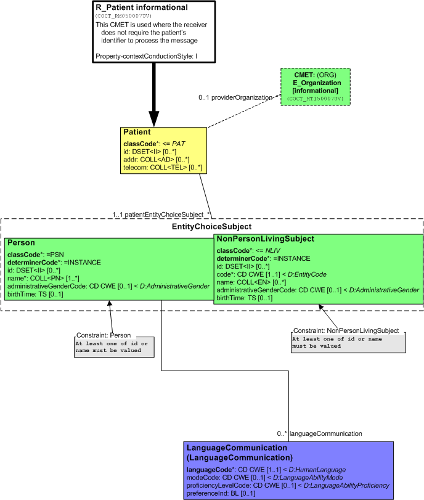
| Parent: | Administrative Registries (PRRG_DM000000UV) |
This is the informational variant of R_Patient universal. This CMET is used where the receiver is assumed not to need the patient's identifier to process the message.
Patient - a role played by a living subject (either a Person or a Non-person Living Subject) as a recipient or potential recipient of health care services from a healthcare provider Organization (represented by E_Organization [informational])
- id - identifiers for this patient (optional)
- addr - addresses for corresponding with the focal living subject in their role as patient
- telecom - telecommunication addresses for communicating with the focal living subject in their role as patient
EntityChoiceSubject - A Living Subject can be either a person or a non-person living subject.
- Person - a specific human being who is or was alive
- id - identifiers for this person (optional)
- name - one or more names for this person (required)
- administrativeGenderCode - value representing the gender (sex) of this person. Note: this attribute does not include terms related to clinical gender which is a complex physiological, genetic and sociological concept that requires multiple observations in order to be comprehensively described.
- birthTime - date and time this person was born. This could be an exact moment such as January 1, 1960 @ 03:00:00 EST or an approximate date such as January 1960.
- Language Communication - the language communication capability of the focal person
- NonPersonLivingSubject -a specific non-person living subject (e.g., animal, microorganism, plant) that is or was alive
- id - identifiers for this non-person living subject (optional)
- code - value representing the specific kind of non-person living subject the instance represents, for example animal or plant taxonomy (required)
- name - names of this non-person living subject
- administrativeGenderCode - value representing the gender (sex) of this non-person living subject. This attribute does not include terms related to clinical gender which is a complex physiological, genetic and sociological concept that requires multiple observations in order to be comprehensively described.
- birthTime - date and time this non-person living subject was born or hatched. This could be an exact moment such as January 1, 1960 @ 03:00:00 EST or an approximate date such as January 1960.
Constraints
- The EntityChoice (Person or NonPersonLivingSubject) must have id or name non-null
| E_OrganizationInformational | COCT_MT150007UV |
| R_Patient informational | COCT_MT050007UV07 |
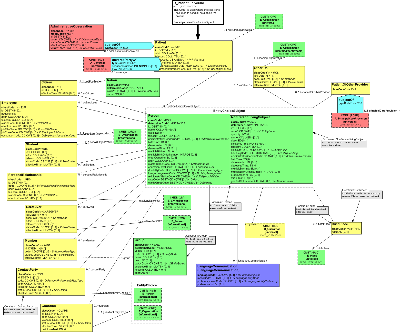
| Parent: | Administrative Registries (PRRG_DM000000UV) |
This is the universal variant of R_Patient. This CMET supports the case where the receiver is assumed to need all data about a living subject patient.
Changes from Previous Version (COCT_RM050000UV01)
- Patient changes conformance of id attribute from Required [1..*] to Optional [0..*]
- Patient changes conformance of statusCode attribute from Optional [1..1] to Optional [0..1]
- Patient adds association to AdministrativeObservation
- Patient adds association to A_Coverage
- Patient playing entity changed from E_LivingSubject [universal] to individual classes due to a tooling limitation that does not allow defining associations leading from CMETs. The PatientOfOtherProvider association from EntityChoiceSubject is not included in the E_LivingSubject [universal] CMET.
- Patient association to LivingSubject changed from [1..1] to [0..1]
- Person changes datatype of name attribute from BAG<EN> to BAG<PN>
- Person removes statusCode attribute
- Person adds telecom and addr attributes
- Person changes classCode attribute domain specification from <= PSN to = PSN
- Person changes determinerCode attribute domain specification from <= INSTANCE to = INSTANCE
- Person adds a constraint requiring that either id or name must be valued
- NonPersonLivingSubject changes determinerCode attribute domain specification from <= INSTANCE+KIND to = INSTANCE
- NonPersonLivingSubject removes statusCode attribute
- NonPersonLivingSubject changes datatype of name attribute from <SET>EN to <BAG>EN
- NonPersonLivingSubject adds code, telecom and deceasedTime attributes
- NonPersonLivingSubject adds a constraint requiring that either id or name must be valued
- EntityChoiceSubject adds new association to PersonalRelationship
- EntityChoiceSubject adds new association to CareGiver
- EntityChoiceSubject removes association to R_CoveredParty [universal]
- Citizen changes association to scoping entity from Optional 1..1 association to E_Organization to Mandatory 1..1 association to Nation
- Citizen changes classCode attribute domain specification from <= CIT to = CIT
- Student corrects datatype of statusCode attribute from SET<CS> to CS
- Student changes classCode attribute domain specification from <= STD to = STD
- Student changes association to scoping organization from E_Organization [universal] to E_Organization [informational]
- Employment renamed Employee
- Employee adds occupationCode attribute
- Employee removes jobCode attribute
- Employee changes association to scoping organization from Optional 0..1 association to E_Organization [universal] to Required 1..1 association to E_Organization [informational]
- Member changes scoping entity from an Optional 1..1 association to Entity to a Required 1..1 association to Group
- Group adds code, telecom and addr attributes
- Group removes quantity attribute
- Group adds a constraint requiring that either id or name must be valued
- Guarantor class replaced with R_Guarantor CMET
- BirthPlace adds addr attribute and changes association to E_Place [universal] from Optional 1..1 to Optional 0..1
- BirthPlace changes classCode attribute domain specification from <= BIRTHPL to = BIRTHPL
- OtherIDs adds code, statusCode and effectiveTime attributes
- OtherIDs changes id attribute from Optional [1..*] to Mandatory [1..*]
- OtherIDs changes scoping organization from Optional 0..1 association to E_Organization [universal] to Required 1..1 association E_Organization[identified/confirmable]
- ContactParty changes playing entity from an Optional 1..1 association to a choice of E_Person [identified/confirmable] or E_Organization [identified/confirmable] to a Required 1..1 association to a choice of E_Person [informational] or E_Organization [informational]
- ContactParty changes code attribute from the AdministrativeContactRoleType domain to the PersonalRelationshipRoleType domain
- ContactParty changes telecom attribute from Mandatory 1..* to Required 0..*
- ContactParty adds constraint requiring that either addr or telecom must be valued
- Guardian changes playing entity from an Optional 1..1 association to a choice of E_Person [identified/confirmable] or E_Organization [identified/confirmable] to a Required 1..1 association to a choice of E_Person [informational] or E_Organization [informational]
Patient - a role played by a living subject (either a Person or a Non-person Living Subject) as a recipient or potential recipient of health care services from a healthcare provider Organization (represented by E_Organization [universal])
- A Patient can be the subject of an Administrative Observation. This can be any type of information that is not represented elsewhere in the information model, for example, a "shared secret".
- A Patient can be covered by an insurance policy or government program conveyed in an A_Coverage CMET
- A Patient of one healthcare Organization may also be the Patient of Other Provider who is responsible for some aspect of the patient's care, i.e., a principal or primary care provider. Note that RIM semantics cause this to be modeled as an association from the Entity Choice Subject.
EntityChoiceSubject - A Living Subject can be either a person or a non-person living subject.
Person - A specific human being who is or was alive.
- id - Identifier(s) for this person. Note that these identifiers can only be used for matching purposes since no scoping organization or status information is included.
- name - Name(s) for this person
- desc - A textual or multimedia depiction of this person. Descriptions are meant to be shown to interested human individuals.
- telecom - Telecommunication address(es) for communicating with this person
- administrativeGenderCode - A value representing the gender (sex) of this person. Note: this attribute does not include terms related to clinical gender which is a complex physiological, genetic and sociological concept that requires multiple observations in order to be comprehensively described.
- birthTime - The date and time this person was born. This could be an exact moment such as January 1, 1960 @ 03:00:00 EST or an approximate date such as January 1960.
- deceasedInd - An indication that this person is dead
- deceasedTime - The date and time this person died. This could be an exact moment such as January 1, 1960 @ 03:00:00 EST or an approximate date such as January 1960.
- multipleBirthInd - An indication that this person was part of a multiple birth
- multipleBirthOrderNumber - The order in which this person was born if part of a multiple birth
- organDonorInd - An indication that this person is a candidate to serve as an organ donor. Note: specifics of an organ donor agreement would be conveyed in a medico-legal document.
- addr - Address(es) for corresponding with this person
- maritalStatusCode - A value representing the domestic partnership status of this person
- educationLevelCode - A value representing the highest level of education this person achieved
- disabilityCode - A set of values identifying this person's disabilities
- livingArrangementCode - A value specifying the housing situation of this person
- religiousAffiliationCode - A value representing the primary religious preference of this person
- raceCode - A set of values representing the races of this person
- ethnicGroupCode - A set of values representing the ethnic groups of this person
NonPersonLivingSubject -A specific non-person living subject (e.g., animal, microorganism, plant) that is or was alive.
- id - Identifier(s) for this non-person living subject. Note that these identifiers can only be used for matching purposes since no scoping organization or status information is included.
- code - A required value representing the specific kind of non-person living subject the instance represents, for example animal or plant taxonomy.
- quantity - For cases where the patient is a group of animals, such as a herd, this specifies the number of animals in the herd.
- name - The name(s) of this non-person living subject
- desc - A textual or multimedia depiction of this non-person living subject. Descriptions are meant to be shown to interested human individuals.
- existenceTime - An interval of time specifying the period in which this non-person living subject physically existed
- telecom - Telecommunication address(es) for communicating with the focal non-person living subject
- riskCode - A value representing the type of hazard or threat associated with this non-person living subject. Animals of irascible temperament may prove to be a risk to healthcare personnel.
- handlingCode - A value representing special handling requirements for this non-person living subject to avoid damage to it or other entities
- administrativeGenderCode - A value representing the gender (sex) of this non-person living subject. This attribute does not include terms related to clinical gender which is a complex physiological, genetic and sociological concept that requires multiple observations in order to be comprehensively described.
- birthTime - The date and time this non-person living subject was born. This could be an exact moment such as January 1, 1960 @ 03:00:00 EST or an approximate date such as January 1960.
- deceasedInd - An indication that this non-person living subject is dead.
- deceasedTime - The date and time this non-person living subject died. This could be an exact moment such as January 1, 1960 @ 03:00:00 EST or an approximate date such as January 1960.
- multipleBirthInd - An indication that this non-person living subject was part of a multiple birth
- multipleBirthOrderNumber - The order in which this non-person living subject was born if part of a multiple birth
- organDonorInd - An indication that this non-person living subject is a candidate to serve as an organ donor
- strainText - A text string representing the specific genotypic or phenotypic variant of this non-person living subject
- genderStatusCode - A value representing whether the primary reproductive organs of this non-person living subject are present
Associations
- Personal Relationship is another living subject related to the focal living subject such as parent, sibling, spouse, neighbor
- Care Giver is a person who provides primary care for the focal living subject at home
- Member is the membership of the focal living subject in a Group such as a family, tribe or religious organization
- Contact Party is a person or organization that is authorized to provide or receive information about the focal living subject
- Guardian is a person or an organization that is legally responsible for the care and management of the focal living subject.
- Guarantor is a person or organization that takes financial responsibility for the health care of the focal living subject
- Birth Place is the location where the focal living subject was born or hatched
- Other IDs conveys identifiers assigned to the focal living subject in other systems
- The Person specialization of Living Subject also includes additional associations:
- Citizen - a relationship between the focal person who owes loyalty to and is entitled by birth or naturalization to the protection of a Nation
- Employee - a relationship of the focal person with an organization to receive wages or salary. The purpose of this class is to identify the type of relationship the employee has to the employer rather than the nature of the work actually performed
- Student - a relationship of the focal person to a school in which they are enrolled
- Language Communication - the language communication capability of the focal person
Constraints
- For Person, either id or name must be non-null
- For NonPersonLivingSubject, either id or name must be non-null
- For BirthPlace, either BirthPlace.addr (physical address) or Place.name must be non-null
- For ContactParty, either addr or telecom must be non-null
- For Group, either id or name must be non-null
| E_LivingSubjectInformational | COCT_MT030007UV |
| E_PersonInformational | COCT_MT030207UV07 |
| E_PersonInformational | COCT_MT030207UV07 |
| E_OrganizationUniversal | COCT_MT150000UV02 |
| E_OrganizationIdentified/confirmable | COCT_MT150002UV01 |
| E_OrganizationInformational | COCT_MT150007UV |
| E_OrganizationInformational | COCT_MT150007UV |
| A_CoverageUniversal | COCT_MT510000UV06 |
| R_GuarantorUniversal | COCT_MT670000UV04 |
| E_PlaceUniversal | COCT_MT710000UV07 |
| A_PrincipalCareProvisionUniversal | COCT_MT820000UV |
| R_Patient universal | COCT_MT050000UV01 |
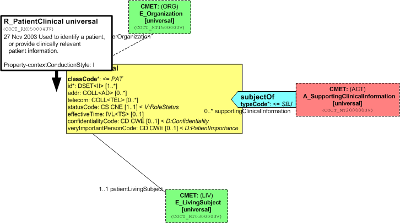
| Parent: | Administrative Registries (PRRG_DM000000UV) |
The R_PatientClinical CMET is similar to R_Patient universal, except that it adds a participation to allow supporting clinical information via the A_SupportingClinicalInformation universal CMET.
| E_LivingSubjectUniversal | COCT_MT030000UV09 |
| E_OrganizationUniversal | COCT_MT150000UV02 |
| A_SupportingClinicalInformationUniversal | COCT_MT200000UV01 |
| R_PatientClinical universal | COCT_MT050004UV01 |
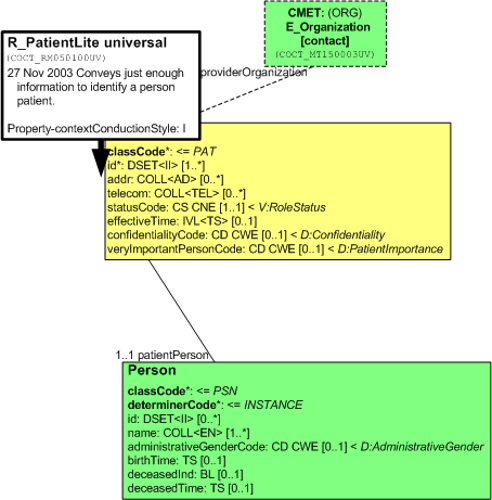
| Parent: | Administrative Registries (PRRG_DM000000UV) |
Use to identify a patient only when minimal patient information is needed (as in the case of a clinical document header in a tightly coupled system). The patient is always a person.
| E_OrganizationContact | COCT_MT150003UV03 |
| R_PatientLite universal | COCT_MT050100UV02 |
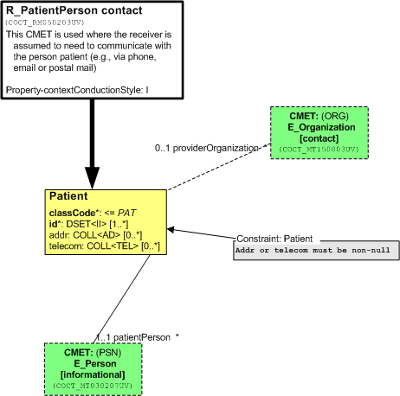
| Parent: | Administrative Registries (PRRG_DM000000UV) |
This is a contact variant of R_Patient universal. This CMET is used where the receiver is assumed to need to communicate with a person patient (e.g., via phone, email or postal mail).
Patient - a role played by a person as a recipient or potential recipient of health care services from a healthcare provider Organization (represented by E_Organization [contact])
- id - one or more identifiers for this patient (mandatory)
- addr - addresses for corresponding with the focal person in his or her role as patient
- telecom - telecommunication addresses for communicating with the focal person in his or her role as patient
- E_Person [informational] - the person playing the role of patient. See E_Person informational for a description
Constraints
- For Patient, either addr or telecom must be non-null
| E_PersonInformational | COCT_MT030207UV07 |
| E_OrganizationContact | COCT_MT150003UV03 |
| R_PatientPerson contact | COCT_MT050203UV07 |
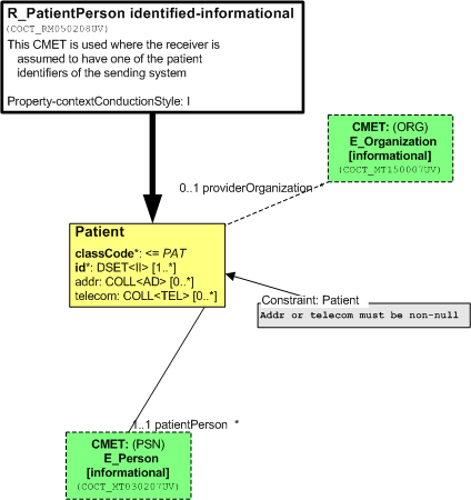
| Parent: | Administrative Registries (PRRG_DM000000UV) |
This is an identified-informational variant of R_Patient universal. This CMET is used where the receiver is assumed to have one of the person patient identifiers of the sending system.
Patient - a role played by a person as a recipient or potential recipient of health care services from a healthcare provider Organization (represented by E_Organization [informational])
- id - one or more identifiers for this patient (mandatory)
- addr - addresses for corresponding with the focal person in his or her role as patient
- telecom - telecommunication addresses for communicating with the focal person in his or her role as patient
- E_Person [informational] - the person playing the role of patient. See E_Person informational for a description
Constraints
- Either addr or telecom must be non-null
| E_PersonInformational | COCT_MT030207UV07 |
| E_OrganizationInformational | COCT_MT150007UV |
| R_PatientPerson identified-informational | COCT_MT050208UV07 |
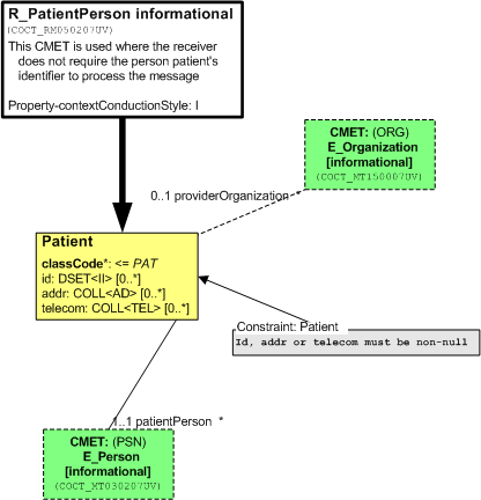
| Parent: | Administrative Registries (PRRG_DM000000UV) |
This is an informational variant of R_Patient universal. This CMET supports the case where the patient is always a person and the receiver is assumed not to need the patient's identifier to process the message.
Patient - a role played by a person as a recipient or potential recipient of health care services from a healthcare provider Organization (represented by E_Organization [informational])
- id - identifiers for this patient (optional)
- addr - addresses for corresponding with the focal living subject in their role as patient
- telecom - telecommunication addresses for communicating with the focal living subject in their role as patient
- E_Person Informational - the person playing the role of patient; at least an id, name, administrativeGenderCode or birthTime will be valued
Constraints
- For Patient, at least one of id, addr or telecom must be non-null
| E_PersonInformational | COCT_MT030207UV07 |
| E_OrganizationInformational | COCT_MT150007UV |
| R_PatientPerson informational | COCT_MT050207UV07 |
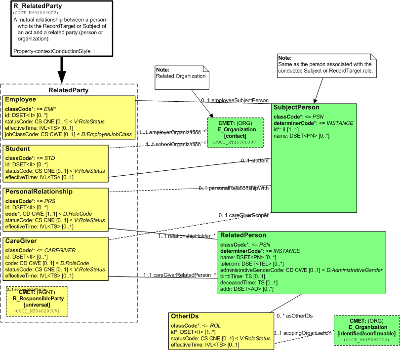
| Parent: | Administrative Registries (PRRG_DM000000UV) |
The R_RelatedParty CMET defines a mutual relationship between a person who is the RecordTarget or Subject of an act and a related party (person or organization).
The RelatedParty choice box offers types of relationships between the subject person and a related party:
- Employee - The subject person (playing entity) is an employee of the related employer organization (scoping entity).
- Student - The subject person (playing entity) is a student of the related school organization (scoping entity).
- PersonalRelationship - The relationship holding person (playing entity) has a personal relationship with the subject person (scoping entity). The mandatory code attribute specifies the type of personal relationship; examples include spouse, parent, sibling, child and unrelated friend.
- CareGiver - The care giving person (playing entity) is responsible for the primary care at home of the subject person (scoping entity).
- R_ResponsibleParty - The agent party (playing entity) is authorized to act on behalf of the subject person (scoping entity). The code attribute specifies the type of agent relationship; examples include guardian and emergency contact.
| R_ResponsiblePartyUniversal | COCT_MT040200UV09 |
| E_OrganizationIdentified/confirmable | COCT_MT150002UV01 |
| E_OrganizationContact | COCT_MT150003UV03 |
| R_RelatedParty universal | COCT_MT910000UV |
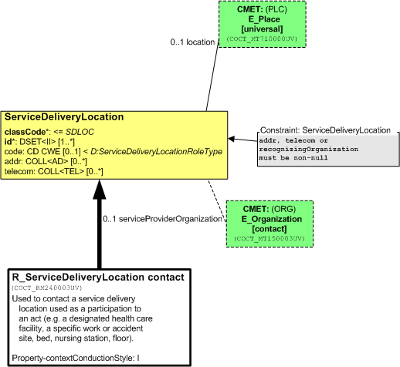
| Parent: | Administrative Registries (PRRG_DM000000UV) |
This is the contact variant of R_ServiceDeliveryLocation universal. This CMET is used where the receiver is assumed to ned to communicate with service delivery location (e.g., via phone, email or postal mail).
ServiceDeliveryLocation - a role played by a Place (represented by E_Place [universal]) at which services may be provided by, or on behalf of, an Organization (represented by E_Organization [contact]).
- id - one or more identifiers for this service delivery location (mandatory)
- code - value further specifying what type of service delivery location this is, drawn from the ServiceDeliveryLocationRoleType domain. A service delivery location may be either an incidental service delivery location (a place at which services may be provided without prior designation or authorization) or a dedicated service delivery location (a place that is intended to house the provision of services). Dedicated service delivery locations can be further characterized as either clinical (DedicatedClinicalLocationRoleType) or non-clinical (DedicatedNonClinicalLocationRoleType).
- addr - addresses for a place playing this service delivery location role
- telecom - telecommunication addresses for a place playing this service delivery location role
Constraints
- At least one of addr, telecom or E_Organization must be non-null
| E_OrganizationContact | COCT_MT150003UV03 |
| E_PlaceUniversal | COCT_MT710000UV07 |
| R_ServiceDeliveryLocation contact | COCT_MT240003UV02 |
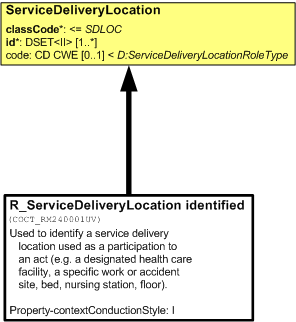
| Parent: | Administrative Registries (PRRG_DM000000UV) |
This is the identified variant of R_ServiceDeliveryLocation universal. This CMET supports the use case of closely coupled systems where the receiver only needs the identifier of the service delivery location.
ServiceDeliveryLocation - A role played by a place at which services may be provided
- id - one or more identifiers for this service delivery location (mandatory)
- code - value further specifying what type of service delivery location this is, drawn from the ServiceDeliveryLocationRoleType domain. A service delivery location may be either an incidental service delivery location (a place at which services may be provided without prior designation or authorization) or a dedicated service delivery location (a place that is intended to house the provision of services). Dedicated service delivery locations can be further characterized as either clinical (DedicatedClinicalLocationRoleType) or non-clinical (DedicatedNonClinicalLocationRoleType).
| R_ServiceDeliveryLocation identified | COCT_MT240001UV02 |
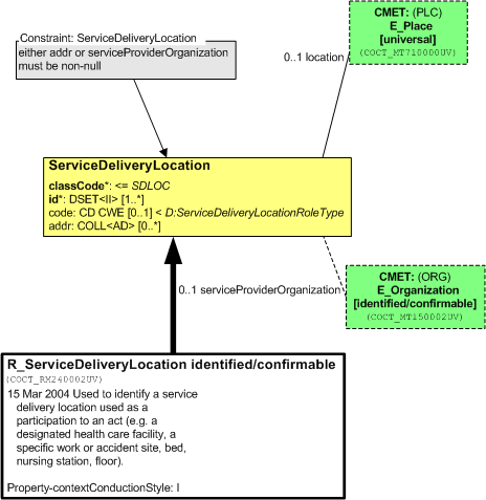
| Parent: | Administrative Registries (PRRG_DM000000UV) |
This is the identified-confirmable variant of R_ServiceDeliveryLocation universal. This CMET is used in cases where the receiver may not have any of the identifiers and requires non-identifier attributes to match.
ServiceDeliveryLocation - a role played by a Place (reprsented by E_Place [universal]) at which services may be provided by, or on behalf of, an Organization (represented by E_Organization [identified/confirmable]).
- id - one or more identifiers for this service delivery location (mandatory)
- code - value further specifying what type of service delivery location this is, drawn from the ServiceDeliveryLocationRoleType domain. A service delivery location may be either an incidental service delivery location (a place at which services may be provided without prior designation or authorization) or a dedicated service delivery location (a place that is intended to house the provision of services). Dedicated service delivery locations can be further characterized as either clinical (DedicatedClinicalLocationRoleType) or non-clinical (DedicatedNonClinicalLocationRoleType).
- addr - addresses for a place playing this service delivery location role
Constraints
- Either addr or E_Organization must be non-null
| E_OrganizationIdentified/confirmable | COCT_MT150002UV01 |
| E_PlaceUniversal | COCT_MT710000UV07 |
| R_ServiceDeliveryLocation identified-confirmable | COCT_MT240002UV02 |
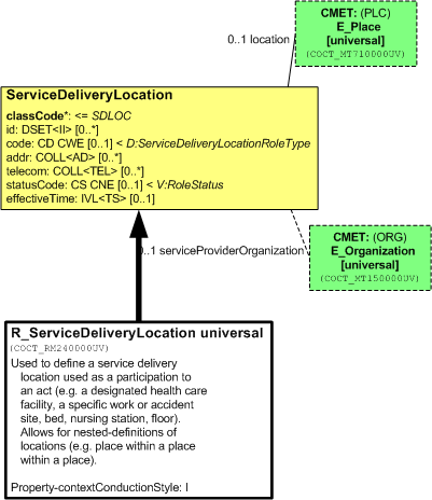
| Parent: | Administrative Registries (PRRG_DM000000UV) |
This is the universal variant of R_ServiceDeliveryLocation. This CMET supports the case where the receiver is assumed to need all data about a service delivery location.
ServiceDeliveryLocation - a role played by a Place (represented by E_Place [universal]) at which services may be provided by, or on behalf of, an Organization (represented by E_Organization [universal]). Note that a single physical place can play multiple service delivery location roles each with its own attributes. For example, a Podiatry clinic and Research clinic may meet on alternate days in the same physical location; each clinic uses its own mailing address and telephone number.
- id - identifiers for this service delivery location
- code - value further specifying what type of service delivery location this is, drawn from the ServiceDeliveryLocationRoleType domain. A service delivery location may be either an incidental service delivery location (a place at which services may be provided without prior designation or authorization) or a dedicated service delivery location (a place that is intended to house the provision of services). Dedicated service delivery locations can be further characterized as either clinical (DedicatedClinicalLocationRoleType) or non-clinical (DedicatedNonClinicalLocationRoleType).
- addr - addresses for a place playing this service delivery location role
- telecom - telecommunication addresses for a place playing this service delivery location role
- statusCode - value specifying the state of this service delivery location (based on the RIM Role class state-machine), for example, pending, active, suspended, terminated.
- effectiveTime - interval of time specifying the period during which this service delivery location role is in effect, if such time limit is applicable and known
| E_OrganizationUniversal | COCT_MT150000UV02 |
| E_PlaceUniversal | COCT_MT710000UV07 |
| R_ServiceDeliveryLocation universal | COCT_MT240000UV01 |
| Return to top of page |


